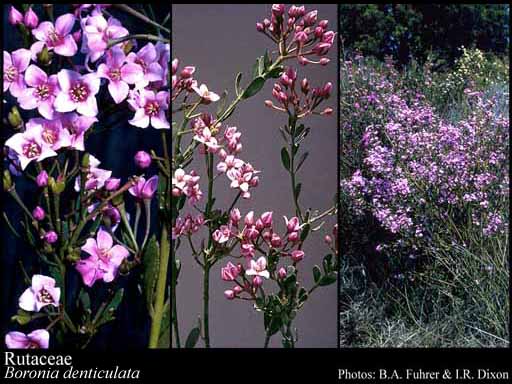- Reference
- Gen.Pl. [Jussieu] 296 (1789)
- Name Status
- Current

Scientific Description
Common name. Boronia Family.
Habit and leaf form. Trees and shrubs (mostly), or herbs (Rutieae); evergreen, or deciduous; bearing essential oils. ‘Normal’ plants, or switch-plants (sometimes with spines); sometimes with the principal photosynthesizing function transferred to stems, or phyllodineous. Leaves well developed, or much reduced. Mesophytic, or xerophytic. Leaves alternate, or opposite; usually spiral; leathery, or ‘herbaceous’; petiolate; non-sheathing; nearly always gland-dotted (exceptions: Leptothyrsa, Phellodendron); aromatic; simple, or compound (usually); when compound (i.e. usually) ternate, or pinnate, or bipinnate, or unifoliolate. Leaf blades when simple dissected, or entire; sometimes linear (and ericoid); when simple/dissected pinnatifid, or much-divided; pinnately veined, or one-veined. Leaves without stipules (usually), or with stipules (rarely). Stipules when present, intrapetiolar; represented by glands. Leaves without a persistent basal meristem. Domatia recorded (from 3 genera); represented by pockets. Stem anatomy. Nodes unilacunar, or tri-lacunar. Secondary thickening developing from a conventional cambial ring.
Reproductive type, pollination. Fertile flowers hermaphrodite, or functionally male and functionally female, or functionally male, or functionally female, or hermaphrodite, functionally male, and functionally female. Unisexual flowers present (rarely), or absent. Plants hermaphrodite (usually), or monoecious, or andromonoecious (rarely), or dioecious, or polygamomonoecious. Entomophilous.
Inflorescence and flower features. Flowers solitary (rarely), or aggregated in ‘inflorescences’; in cymes, in panicles, in racemes, and in corymbs. The terminal inflorescence unit cymose (usually), or racemose. Inflorescences terminal, or axillary, or epiphyllous (rarely). Flowers bracteate; small to medium-sized; commonly fragrant; regular (usually), or somewhat irregular. The floral asymmetry when noticeable, involving the perianth and involving the androecium (not K). Flowers mostly (3–)5 merous; cyclic. Floral receptacle developing a gynophore (associated with the disk), or with neither androphore nor gynophore. Free hypanthium absent. Hypogynous disk present; intrastaminal; annular (sometimes one-sided), or of separate members (e.g. in Coleonema). Perianth with distinct calyx and corolla (but the calyx sometimes minute and inconspicuous); (3–)6, or (6–)10; 2 -whorled; isomerous. Calyx (3–)4, or 5; 1 -whorled; polysepalous, or gamosepalous (basally); imbricate; regular; with the median member posterior. Corolla (3–)4, or 5; 1 -whorled; polypetalous, or gamopetalous; imbricate (the odd petal anterior); regular, or unequal but not bilabiate. Fertile stamens present, or absent (from female flowers). Androecium 2, or 3, or 5, or 8, or 10, or 20–60. Androecial members unbranched, or branched (by the splitting of simple primordia, e.g. in Citrus); free of the perianth; all equal, or markedly unequal; free of one another, or coherent (the filaments usually more or less basally connate); 1 - adelphous, or 3–12 - adelphous (‘polyadelphous’ in Citrus); 1 -whorled, or 2 -whorled. Androecium exclusively of fertile stamens, or including staminodes. Staminodes (often representing the antepetalous whorl) (3–)4, or 5(–10). Stamens 2–60; reduced in number relative to the adjacent perianth to polystemonous; alternisepalous, or oppositisepalous (when the outer whorl lost). Anthers dorsifixed, or basifixed (more or less, e.g.Erythrochiton, Melicope); versatile; dehiscing via longitudinal slits; introrse (usually), or latrorse (more or less, e.g. Dictamnus); tetrasporangiate. Fertile gynoecium present, or absent (from male flowers). Gynoecium (1–)3 carpelled (rarely), or 4–5(–100) carpelled (rarely ‘many’, e.g. in Citrus). The pistil when syncarpous, (1–)4–5(–100) celled. Gynoecium apocarpous to syncarpous; eu-apocarpous, or synstylous, or semicarpous to synovarious (the carpels commonly more or less united basally or at the sides), or synstylovarious to eu-syncarpous (in the Aurantioideae); superior (most commonly), or partly inferior (Platyspermation), or inferior (Aurantioideae). Carpel (when apo- or semicarpous) (1–)2–100 ovuled (i.e. to many). Placentation of the free carpels marginal. Ovary unilocular, or plurilocular; when syncarpous, (1–)4–5(–100) locular (i.e. sometimes ‘many’). Styles 1, or 3–5; free, or partially joined; apical. Stigmas wet type, or dry type; papillate, or non-papillate; Group II type, or Group IV type. Placentation when syncarpous, axile. Ovules 1–5(–50) per locule (i.e. to many); pendulous to ascending; epitropous; sometimes with a branching raphe; when two or more per cell, collateral, or superposed, or biseriate; arillate, or non-arillate; anatropous, or hemianatropous.
Fruit and seed features. Fruit fleshy, or non-fleshy; an aggregate, or not an aggregate. The fruiting carpels coalescing into a secondary syncarp, or not coalescing. The fruiting carpel dehiscent, or indehiscent; (when apocarpous) a follicle, or drupaceous, or baccate. Fruit (when syncarpous) dehiscent, or indehiscent, or a schizocarp. Mericarps when schizocarpic, comprising berrylets, or comprising follicles, or comprising nutlets, or comprising drupelets. Fruit when syncarpous and non-schizocarpic, a berry (often in the form of a hesperidium), or a drupe. Seeds endospermic, or non-endospermic. Embryo well differentiated. Cotyledons 2. Embryo chlorophyllous (6/17), or achlorophyllous (3/7); straight, or curved, or bent. Seedling. Germination phanerocotylar, or cryptocotylar.
Physiology, biochemistry. Aluminium accumulation not found. Photosynthetic pathway: C3.
Geography, cytology, number of species. World distribution: pantropical and subtropical, and widespread temperate. X = 7–11(+). 900 species.
Economic uses, etc. Many edible fruits from Citrus spp., Aegle, Casimiroa, Clausena etc. (orange, lemon, lime, grapefruit, citron, Bengal quince or bael fruit, casimiroa or white sapote, wampee, etc.); several are or have been officinal (Ruta, Galipea, Toddalia, chiefly on account of their oils).
Keys
Key to the Rutaceae of Western Australia
C. Hollister, K.R. Thiele